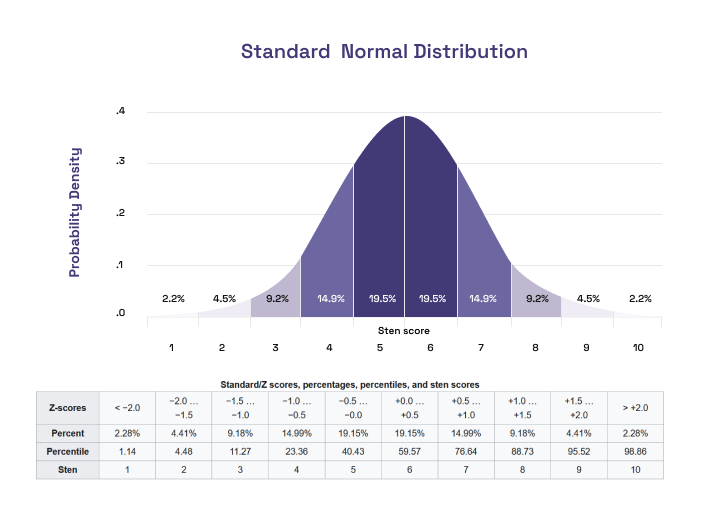If you took the Big Five Personality Questionnaire on Talent Alpha’s Human Cloud Platform, you measured several psychological traits that describe the fundamental characteristics of your personality. Find out more about the meaning of your results and the questionnaire itself below.
What is the Big Five Personality Questionnaire?
The Big Five Personality Questionnaire is a tool that allows you to measure five dimensions of your personality. The five-factor model by Costa and McCrae1 (they created the theory behind this questionnaire), is one of the most widely used and well-researched models of human personality of all time. The traits measured in the model are:
- Universal – meaning that every individual in any culture on earth can get a score somewhere on the spectrum
- Dimensional – meaning that the questionnaire doesn’t classify people into distinct “personality types”, but acknowledges that you can possess each trait “to some extent”
Personality tests tend to be long and time-consuming. In 1992, a scientist named Goldberg2 created a shortened version of a tool for measuring markers of the five factors of personality – and our questionnaire is based on that version.
Is it just a quiz?
No, our version of the Big Five Personality Questionnaire is a psychometric test with tested and proven reliability and validity. Because we don’t have enough data to compare your results to other specialists on the Talent Alpha platform, we compare your results to a sample set from an international database of over 1.5 million records. Big Five Personality results are standardized and individual results can be compared to the reference group – thanks to that, you can quite precisely understand what percent of people exhibit more or less extraversion, agreeableness or openness.
What does the Big Five Personality measure?
- Introversion – Extraversion
The extraversion scale concerns how sociable and outgoing people are. Those with higher results draw energy from or recharge by interacting with others, while those with lower results get tired when interacting with others.
- Openness – Consistency
The openness experience scale concerns people’s willingness to try new things and their capability to think outside the box. People’s openness ranges from very traditional and conventional to very curious, daring and innovative.
- Conscientiousness – Spontaneity
The conscientiousness scale measures the tendency to control impulses and facilitate goal-directed behavior. People’s conscientiousness ranges from more spontaneous and impulsive to more self-disciplined and persistent.
- Emotional Stability – Emotional Reactivity
The emotional stability scale measures confidence, general temperament and being comfortable in one’s own skin. People’s emotional stability ranges from very emotionally sensitive and tense to very confident and sure of themselves.
- Agreeableness – Competitiveness
The agreeableness scale refers to how people tend to treat others in relationships. People’s agreeableness ranges from more competitive, straightforward and cold to more unselfish, warm and helpful.
How should I interpret my results?
Your results are presented on a scale from 1 to 10. This is a standard scale that reflects the normal distribution of the psychological trait in the population. In easier words, your score can tell how you compare to others.

If you have a score of 5, it means that 50% of people scored lower, and 50% higher than you. If you have the score of 10 – it means that your trait is stronger than 97,72% other IT Specialists on our platform. Because of this correlation, your score can change over time – as more Specialists take the test, we will change the reference group from the general population to the population of IT Specialists on our Platform.
Besides a single score, you can also see a colored belt to the left and right of your score – this is our way of showing our confidence in your result. It is an honest approach that takes into account the limitations of the measurement. Because of natural fluctuations of your mood or focus and inevitable measurement error your true trait level lies somewhere in this colored spectrum (with 85% confidence interval). We take into account that the result could be slightly different if you took the measurement on the other day and try to reflect it in a way we communicate the results.
Which results are good and which are bad?
There are no good or bad levels of a given trait. Their variance is an effect of the neurodiversity of human beings. They give us an advantage in certain situations, so the right match between your personality and the context is key to your satisfaction and productivity.
Some of the results may not seem positive to you in an obvious way. Those whose score on the extraversion scale is lower than in 98% of the population belong to the 2% of the most solitary and reserved. They don’t feel the need to be in the spotlight, they have the ability to listen attentively to others and they recharge their energy supply by spending time alone with themselves. Those, whose score on this scale is higher than 98% of the population, belong to the 2% of the most outgoing and loud. These people love being in the centre of attention, are first to start talking and they draw energy from social interactions. Bear in mind, that most people land somewhere in between those extremes. Think about your traits as your strengths – as patterns of behavior that you exercised and strengthened because they have allowed you to adapt to your surroundings as best as you can so far.
References:
1 McCrae, R., & Costa, P. (1987). Validation of the five-factor model of personality across instruments and observers. Journal of personality and social psychology, 52 1, 81-90.
2 Goldberg, L. R. (1992). The development of markers for the Big-Five factor structure. Psychological Assessment, 4, 26-42.


Read also
The Human Cloud Ecosystem - Re-Shaping the Business World
Although cloud service was already on the rise before the pandemic, it wasn’t a necessity for many of the people in the industry. What has changed since then?
How Cloud Technology Became More Human
Working remotely has never been as popular as it is now, clearly demonstrating that its perks outweigh its disadvantages. Read more about it here.
VIDEO: Bridge Your Tech Talent Gap Webinar
On Wednesday March 3rd, Talent Alpha hosted our webinar Talent Intelligence in 2021: Understand, Unlock & Unleash Hidden Value in Your Organization